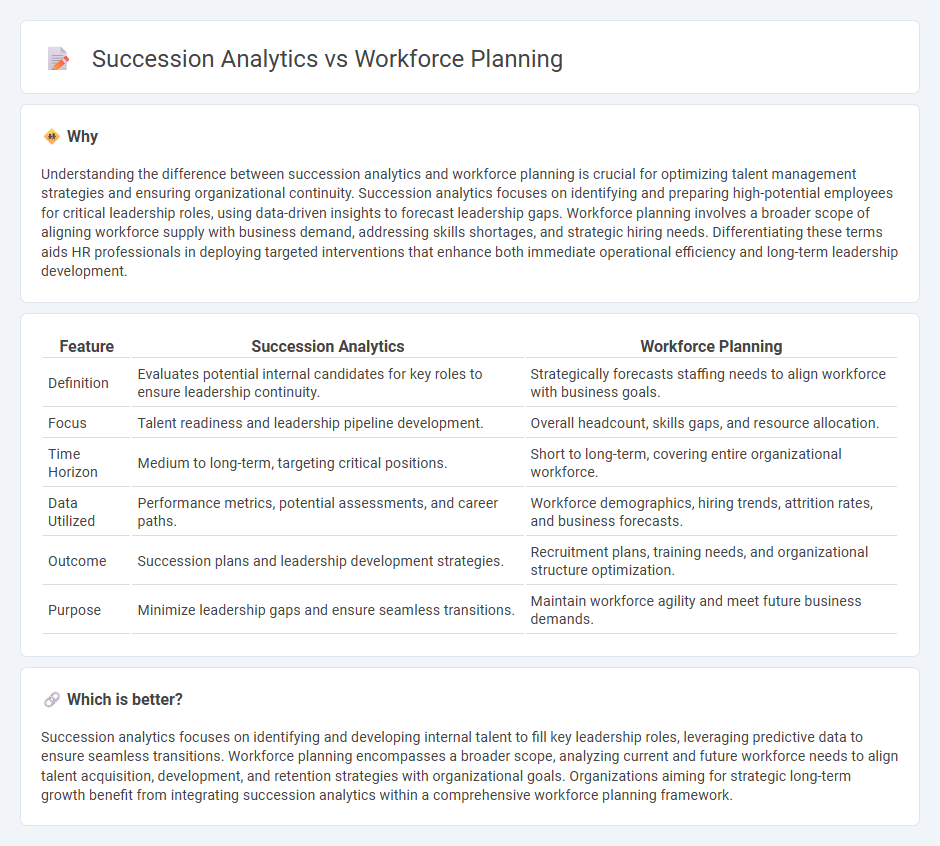
Succession analytics leverages data-driven insights to identify and develop future leaders, ensuring a seamless transition in key roles within an organization. Workforce planning focuses on aligning talent acquisition and deployment with business goals to meet current and future workforce demands effectively. Explore how integrating succession analytics with workforce planning can optimize talent management strategies.
Why it is important
Understanding the difference between succession analytics and workforce planning is crucial for optimizing talent management strategies and ensuring organizational continuity. Succession analytics focuses on identifying and preparing high-potential employees for critical leadership roles, using data-driven insights to forecast leadership gaps. Workforce planning involves a broader scope of aligning workforce supply with business demand, addressing skills shortages, and strategic hiring needs. Differentiating these terms aids HR professionals in deploying targeted interventions that enhance both immediate operational efficiency and long-term leadership development.
Comparison Table
| Feature | Succession Analytics | Workforce Planning |
|---|---|---|
| Definition | Evaluates potential internal candidates for key roles to ensure leadership continuity. | Strategically forecasts staffing needs to align workforce with business goals. |
| Focus | Talent readiness and leadership pipeline development. | Overall headcount, skills gaps, and resource allocation. |
| Time Horizon | Medium to long-term, targeting critical positions. | Short to long-term, covering entire organizational workforce. |
| Data Utilized | Performance metrics, potential assessments, and career paths. | Workforce demographics, hiring trends, attrition rates, and business forecasts. |
| Outcome | Succession plans and leadership development strategies. | Recruitment plans, training needs, and organizational structure optimization. |
| Purpose | Minimize leadership gaps and ensure seamless transitions. | Maintain workforce agility and meet future business demands. |
Which is better?
Succession analytics focuses on identifying and developing internal talent to fill key leadership roles, leveraging predictive data to ensure seamless transitions. Workforce planning encompasses a broader scope, analyzing current and future workforce needs to align talent acquisition, development, and retention strategies with organizational goals. Organizations aiming for strategic long-term growth benefit from integrating succession analytics within a comprehensive workforce planning framework.
Connection
Succession analytics leverages data-driven insights to identify potential leadership candidates, enhancing workforce planning by forecasting skill gaps and talent needs. Integrating succession analytics with workforce planning ensures organizations proactively develop internal talent pipelines and align human capital strategies with long-term business goals. This connection optimizes talent retention, minimizes disruption in leadership transitions, and strengthens overall organizational resilience.
Key Terms
**Workforce Planning:**
Workforce planning involves analyzing current employee skills, forecasting future talent needs, and aligning workforce capabilities with organizational goals to ensure optimal staffing levels. It integrates data on employee demographics, turnover rates, and labor market trends to create strategic hiring and development plans. Explore how advanced workforce planning techniques can enhance your organization's talent strategy and operational efficiency.
Talent Acquisition
Workforce planning focuses on forecasting talent needs and aligning recruitment strategies to meet future organizational goals, while succession analytics targets identifying and developing internal candidates for key roles to ensure leadership continuity. Talent acquisition benefits from workforce planning by targeting the right skill sets and demographics, whereas succession analytics enhances retention by preparing high-potential employees for advancement. Discover how integrating both approaches can optimize talent acquisition and build a resilient workforce.
Skills Gap Analysis
Workforce planning and succession analytics both address skills gap analysis but differ in scope and application; workforce planning emphasizes identifying current and future skill shortages across the organization to optimize resource allocation, while succession analytics focuses on pinpointing skill deficiencies within leadership pipelines to ensure seamless transitions. Leveraging data-driven insights from employee performance, training records, and market trends enhances the accuracy of skills gap assessments for targeted upskilling initiatives. Explore how integrating these approaches can strengthen your organization's talent strategy and leadership continuity.
Source and External Links
What Is Workforce Planning? Strategies and Benefits - Paychex - Workforce planning is the process of analyzing an organization's future staffing needs and developing strategies to meet those requirements through assessing current workforce, forecasting future needs, identifying gaps, developing action plans, and continuously monitoring.
Workforce Planning: Definition, Process and Principles | Indeed.com - Workforce planning, also called strategic workplace planning, involves determining organizational strategic direction, conducting supply and demand analysis of talent, and aligning workforce capabilities with business goals.
Workforce Planning - NIH: Office of Human Resources - Workforce planning is the process of analyzing, forecasting, and planning workforce supply and demand, assessing gaps, and applying talent management actions to ensure the right people are in place to fulfill strategic objectives.
 dowidth.com
dowidth.com